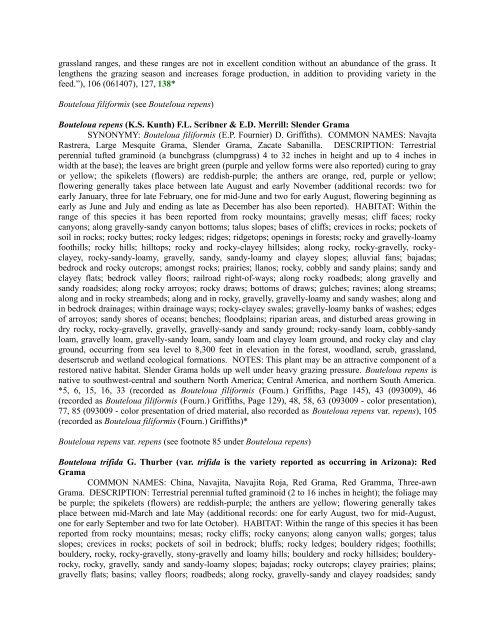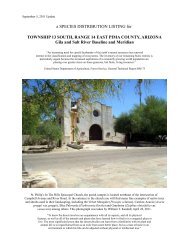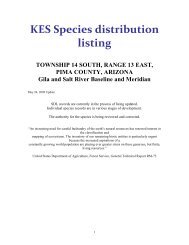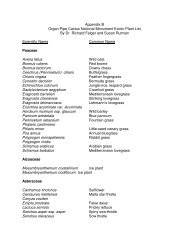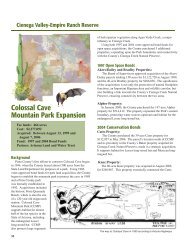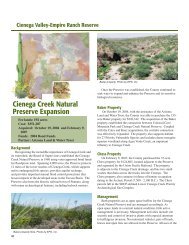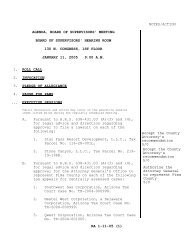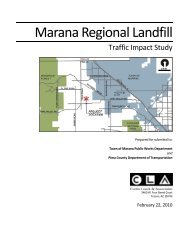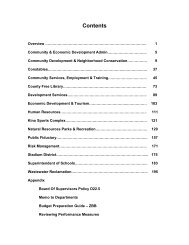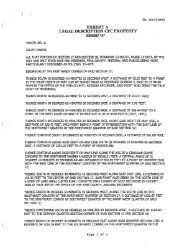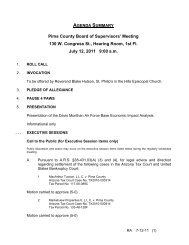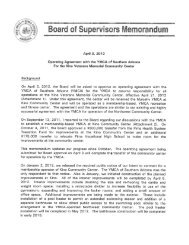Le Jardin de Mère Nature dans une Petite Planète - Pima County
Le Jardin de Mère Nature dans une Petite Planète - Pima County
Le Jardin de Mère Nature dans une Petite Planète - Pima County
You also want an ePaper? Increase the reach of your titles
YUMPU automatically turns print PDFs into web optimized ePapers that Google loves.
grassland ranges, and these ranges are not in excellent condition without an abundance of the grass. It<br />
lengthens the grazing season and increases forage production, in addition to providing variety in the<br />
feed.”), 106 (061407), 127, 138*<br />
Bouteloua filiformis (see Bouteloua repens)<br />
Bouteloua repens (K.S. Kunth) F.L. Scribner & E.D. Merrill: Slen<strong>de</strong>r Grama<br />
SYNONYMY: Bouteloua filiformis (E.P. Fournier) D. Griffiths). COMMON NAMES: Navajta<br />
Rastrera, Large Mesquite Grama, Slen<strong>de</strong>r Grama, Zacate Sabanilla. DESCRIPTION: Terrestrial<br />
perennial tufted graminoid (a bunchgrass (clumpgrass) 4 to 32 inches in height and up to 4 inches in<br />
width at the base); the leaves are bright green (purple and yellow forms were also reported) curing to gray<br />
or yellow; the spikelets (flowers) are reddish-purple; the anthers are orange, red, purple or yellow;<br />
flowering generally takes place between late August and early November (additional records: two for<br />
early January, three for late February, one for mid-J<strong>une</strong> and two for early August, flowering beginning as<br />
early as J<strong>une</strong> and July and ending as late as December has also been reported). HABITAT: Within the<br />
range of this species it has been reported from rocky mountains; gravelly mesas; cliff faces; rocky<br />
canyons; along gravelly-sandy canyon bottoms; talus slopes; bases of cliffs; crevices in rocks; pockets of<br />
soil in rocks; rocky buttes; rocky ledges; ridges; ridgetops; openings in forests; rocky and gravelly-loamy<br />
foothills; rocky hills; hilltops; rocky and rocky-clayey hillsi<strong>de</strong>s; along rocky, rocky-gravelly, rockyclayey,<br />
rocky-sandy-loamy, gravelly, sandy, sandy-loamy and clayey slopes; alluvial fans; bajadas;<br />
bedrock and rocky outcrops; amongst rocks; prairies; llanos; rocky, cobbly and sandy plains; sandy and<br />
clayey flats; bedrock valley floors; railroad right-of-ways; along rocky roadbeds; along gravelly and<br />
sandy roadsi<strong>de</strong>s; along rocky arroyos; rocky draws; bottoms of draws; gulches; ravines; along streams;<br />
along and in rocky streambeds; along and in rocky, gravelly, gravelly-loamy and sandy washes; along and<br />
in bedrock drainages; within drainage ways; rocky-clayey swales; gravelly-loamy banks of washes; edges<br />
of arroyos; sandy shores of oceans; benches; floodplains; riparian areas, and disturbed areas growing in<br />
dry rocky, rocky-gravelly, gravelly, gravelly-sandy and sandy ground; rocky-sandy loam, cobbly-sandy<br />
loam, gravelly loam, gravelly-sandy loam, sandy loam and clayey loam ground, and rocky clay and clay<br />
ground, occurring from sea level to 8,300 feet in elevation in the forest, woodland, scrub, grassland,<br />
<strong>de</strong>sertscrub and wetland ecological formations. NOTES: This plant may be an attractive component of a<br />
restored native habitat. Slen<strong>de</strong>r Grama holds up well un<strong>de</strong>r heavy grazing pressure. Bouteloua repens is<br />
native to southwest-central and southern North America; Central America, and northern South America.<br />
*5, 6, 15, 16, 33 (recor<strong>de</strong>d as Bouteloua filiformis (Fourn.) Griffiths, Page 145), 43 (093009), 46<br />
(recor<strong>de</strong>d as Bouteloua filiformis (Fourn.) Griffiths, Page 129), 48, 58, 63 (093009 - color presentation),<br />
77, 85 (093009 - color presentation of dried material, also recor<strong>de</strong>d as Bouteloua repens var. repens), 105<br />
(recor<strong>de</strong>d as Bouteloua filiformis (Fourn.) Griffiths)*<br />
Bouteloua repens var. repens (see footnote 85 un<strong>de</strong>r Bouteloua repens)<br />
Bouteloua trifida G. Thurber (var. trifida is the variety reported as occurring in Arizona): Red<br />
Grama<br />
COMMON NAMES: China, Navajita, Navajita Roja, Red Grama, Red Gramma, Three-awn<br />
Grama. DESCRIPTION: Terrestrial perennial tufted graminoid (2 to 16 inches in height); the foliage may<br />
be purple; the spikelets (flowers) are reddish-purple; the anthers are yellow; flowering generally takes<br />
place between mid-March and late May (additional records: one for early August, two for mid-August,<br />
one for early September and two for late October). HABITAT: Within the range of this species it has been<br />
reported from rocky mountains; mesas; rocky cliffs; rocky canyons; along canyon walls; gorges; talus<br />
slopes; crevices in rocks; pockets of soil in bedrock; bluffs; rocky ledges; boul<strong>de</strong>ry ridges; foothills;<br />
boul<strong>de</strong>ry, rocky, rocky-gravelly, stony-gravelly and loamy hills; boul<strong>de</strong>ry and rocky hillsi<strong>de</strong>s; boul<strong>de</strong>ryrocky,<br />
rocky, gravelly, sandy and sandy-loamy slopes; bajadas; rocky outcrops; clayey prairies; plains;<br />
gravelly flats; basins; valley floors; roadbeds; along rocky, gravelly-sandy and clayey roadsi<strong>de</strong>s; sandy


